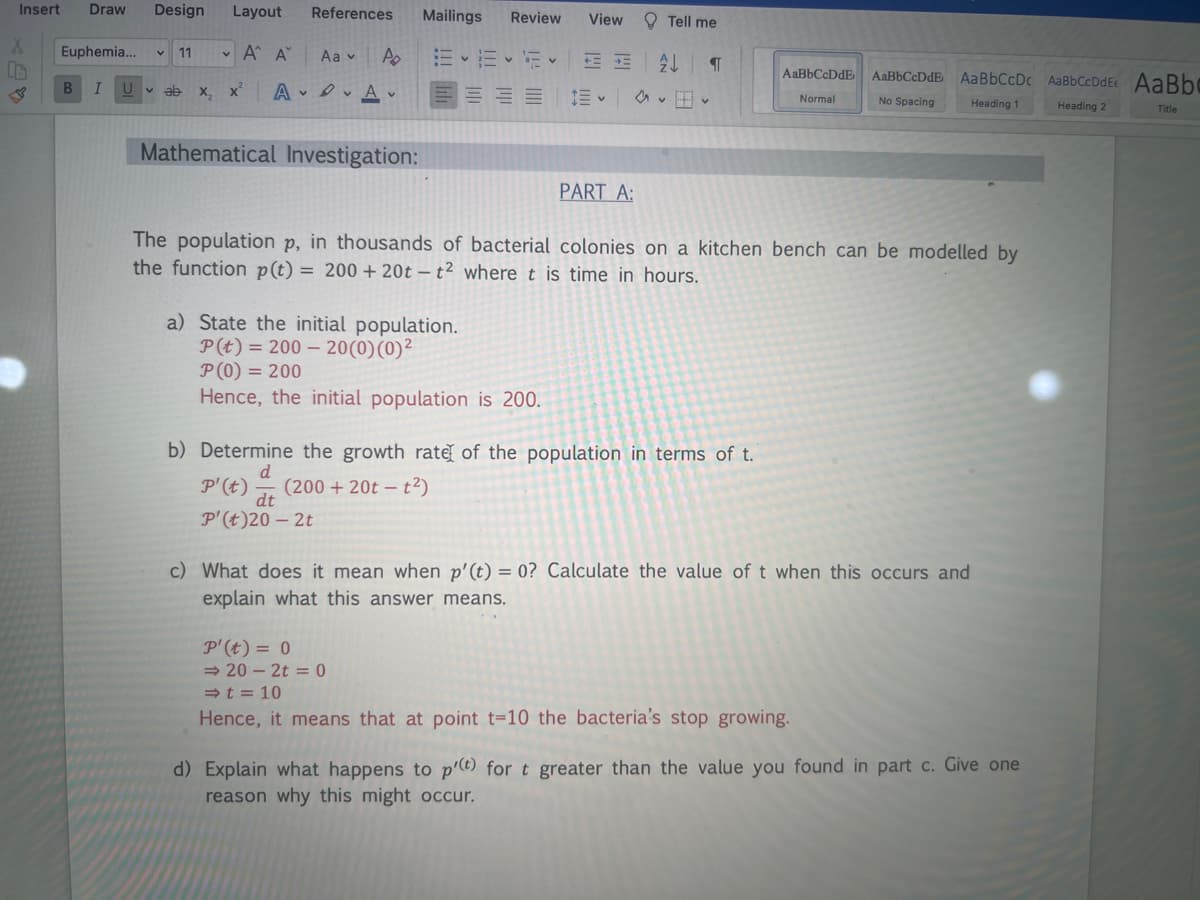Calculus: Early Transcendentals
8th Edition
ISBN:9781285741550
Author:James Stewart
Publisher:James Stewart
Chapter1: Functions And Models
Section: Chapter Questions
Problem 1RCC: (a) What is a function? What are its domain and range? (b) What is the graph of a function? (c) How...
Related questions
Question
Answer question D

Transcribed Image Text:Insert Draw Design Layout References Mailings
X
• Α' Α'
16
Euphemia...
11
B I U vab X₂ X²
Po
A A
Aav
Mathematical Investigation:
Review
≡≡≡
v
a) State the initial population.
P(t) = 200- 20(0) (0)²
P(0) = 200
Hence, the initial population is 200.
View
PART A:
Tell me
2↓ ¶
The population p, in thousands of bacterial colonies on a kitchen bench can be modelled by
the function p(t) = 200 + 20t - t2 where t is time in hours.
AaBbCcDdE. AaBbCcDdE Aa BbCcDc AaBbCcDdE Aa Bb
Normal
No Spacing
Heading 1
Heading 2
b) Determine the growth rate of the population in terms of t.
d
P' (t) (200 + 20t-t²)
dt
P'(t)20-2t
c) What does it mean when p'(t) = 0? Calculate the value of t when this occurs and
explain what this answer means.
P'(t) = 0
⇒ 20-2t = 0
⇒ t = 10
Hence, it means that at point t=10 the bacteria's stop growing.
d) Explain what happens to p'(t) for t greater than the value you found in part c. Give one
reason why this might occur.
Title
Expert Solution
This question has been solved!
Explore an expertly crafted, step-by-step solution for a thorough understanding of key concepts.
Step by step
Solved in 3 steps

Recommended textbooks for you

Calculus: Early Transcendentals
Calculus
ISBN:
9781285741550
Author:
James Stewart
Publisher:
Cengage Learning

Thomas' Calculus (14th Edition)
Calculus
ISBN:
9780134438986
Author:
Joel R. Hass, Christopher E. Heil, Maurice D. Weir
Publisher:
PEARSON

Calculus: Early Transcendentals (3rd Edition)
Calculus
ISBN:
9780134763644
Author:
William L. Briggs, Lyle Cochran, Bernard Gillett, Eric Schulz
Publisher:
PEARSON

Calculus: Early Transcendentals
Calculus
ISBN:
9781285741550
Author:
James Stewart
Publisher:
Cengage Learning

Thomas' Calculus (14th Edition)
Calculus
ISBN:
9780134438986
Author:
Joel R. Hass, Christopher E. Heil, Maurice D. Weir
Publisher:
PEARSON

Calculus: Early Transcendentals (3rd Edition)
Calculus
ISBN:
9780134763644
Author:
William L. Briggs, Lyle Cochran, Bernard Gillett, Eric Schulz
Publisher:
PEARSON

Calculus: Early Transcendentals
Calculus
ISBN:
9781319050740
Author:
Jon Rogawski, Colin Adams, Robert Franzosa
Publisher:
W. H. Freeman


Calculus: Early Transcendental Functions
Calculus
ISBN:
9781337552516
Author:
Ron Larson, Bruce H. Edwards
Publisher:
Cengage Learning